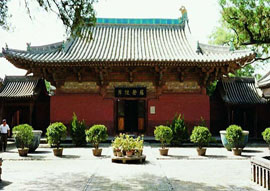The Zhenguo Temple sits in Haodong Village, northeast of Pingyao County, Shanxi Province.
Built in 963, the temple was abandoned in the Ming (1368-1644)-Qing (1644-1911) period. The main hall, the Wanfo Hall (Ten-Thousand-Buddha Hall), which currently stands in the center of the front courtyard, was restored in 1815 during the Qing Dynasty. The God Hall was built near the mountain gate and contains statues of the four gods. The bell and drum towers were erected at the side of the hall. Most of the 20 stone tablets located in the east and west corridors recount the temple's history. Situated in the backyard are the Kwan-yin Hall, the Ksitigarbha Hall and the Three-Buddha Building. All of the halls, except the Kwan-yin Hall, contain various statues. Frescos painted on the gable walls of the Three-Buddha Building tell the life story of Sakyamuni. The frescos are elaborate works of the Ming period.
The earliest construction at the temple, the Wanfo Hall is three bays wide and three bays deep. Square in shape, the hall has a gable and hip roof with protrusive, single-layered eaves. Its bracket set is over 2-3 columns high — a rarity in ancient temples. Eleven temple statues — including the Buddha, two of his followers, four Bodhisattvas, two gods and two of Bodhisattva's attendants — are of high artistic value. The statues are all characterized by a plump facial outline from the Five Dynasties Period (907-960). Two rare trees grow at the Wanfo Temple, namely the Dragon and Tiger Pagoda trees. A stone tablet inscribed with Notes on the Dragon Pagoda Tree in the Zhenguo Temple is embedded in t |
